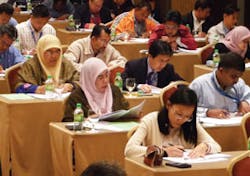CPESC Certification Makes Rapid Gains in Malaysia
In just one year’s time-from August 2007 to August 2008-the number of Certified Professional in Erosion and Sediment Control (CPESC) registrants in Malaysia increased dramatically from one to 96.
The driving force behind this achievement is Malaysia’s Drainage and Irrigation Department. Under the leadership of its director general, civil engineer Dato’ Ahmad Hussaini, and the department’s recently retired deputy director general, Dato’ Ahmad Fuad Embi, CPESC, the EnviroCert International Inc.’s certification process is being used to complement Malaysia’s Urban Stormwater Management program. This program is designed to reduce sediment-laden waterways and control erosion from construction projects throughout the country.
Adding More Registrants
The CPESC program identifies professionals who are qualified for educational, scientific, and service activities with public and private agencies in this field of work by their scholarly preparation, knowledge, and experience.
Embi and Hussaini have been assisted in promoting the CPESC program by civil engineer Kwok Wing Leong, the first CPESC and CPSWQ registrant to work in Malaysia. In addition to serving as interpreter on both sides of the Pacific Ocean, Leong has managed the logistics involved in conducting the CPESC review sessions and the certification exams.
“Without the efforts of these three individuals, the success in certifying the CPESC candidates in Malaysia would never have happened,” says David Ward, executive director of EnviroCert International.
Leong lists the major objectives of the plan to bolster the CPESC program in Malaysia:
- Develop a designated core group of 150 to 300 CPESC Malaysia registrants.
- Increase the number of CPESC candidates by using this core group to “train the trainers” in preparing applicants for the CPESC written exam.
- Work with local consultants and universities to develop charts and nomographs of rainfall intensities and patterns and soil erosivities specific to Malaysia.
- “Develop a Malaysian version of the CPESC review session and exam.
Getting Started
Efforts to establish a strong CPESC presence in Malaysia began in August 2006. That’s when Embi led a small group of senior government engineers and private-sector consultants to the annual StormCon stormwater management conference, held that year in Denver, CO.
As the only Malaysian CPESC registrant, Leong arranged for EnviroCert International executive director David Ward and Ted Sherrod, who then chaired the CPESC Council, to meet with the Malaysian delegation. “After a lively interaction, the Council agreed to conduct the CPESC examination in Malaysia for a group of pre-qualified Malaysians, who in turn, would form the core of a CPESC organization in Malaysia,” Leong says. “It would have been too costly for the group to take the examinations in the United States.”
The exam was scheduled for early 2007 and Eric Berntsen, CPESC, CPSWQ, CPESC Council Technical vice chair, was assigned to work with the Malaysia group. In February of that year, two Malaysian engineers attended the annual conference of the International Erosion Control Association (IECA) in Reno, NV, where they took the CPESC exam. They also met with the CPESC Technical and Exam Committee composed of David Walker, CPESC; Jennifer Hildebrand, CPESC, CPSWQ; and Berntsen for more discussions about increasing the number of CPESC registrants in Malaysia.
In August 2007, Berntsen and Leong conducted the CPESC review and exam at Penang Island in Malaysia. These sessions were arranged by the University of Science Malaysia (USM), River Engineering and Drainage Department (REDAC).
Test Time
“More than 100 people attended that first CPESC review and exam workshop, and 25 candidates took the exam,” Leong says. “Our efforts were rewarded with 12 engineers from Malaysia and another from Singapore passing the exam. The Singaporean engineer is chair of the Environment Engineering Section of the Institute of Engineers in Singapore and also heads the Singapore QEP program, which is similar to the CPESC program.”
In February 2008, Hussaini and more than a dozen Malaysian engineers met with the CPESC Executive Council at the IECA annual conference in Orlando, FL. The Malaysian delegation requested EnviroCert International to conduct a second CPESC review and exam in Malaysia in August 2008. “The purpose was to establish a larger core group of CPESC members in the country, since the first group of 12 registrants was too small to build momentum in the program.
Again, Berntsen and Leong conducted the CPESC review and exam at Penang Island, Malaysia. As before, it was organized by the USM REDAC.
“The overwhelming response to these courses was beyond expectations,” Leong says. “Although we sent invitations to major players in the field of erosion and sediment control, most of the publicity was by word-of-mouth. We had to add tables and chairs to accommodate the 109 candidates who attended the review session and took the exam.”
Candidates’ Profiles
The CPESC candidates represented a wide range of erosion and sediment control professionals:
Academic Qualifications (number): Advanced Diploma-2; BSc-87; MSc-15; Ph.D. -5.
Discipline/Field of Expertise/Profession: civil, structural, and geotechnical engineering (90%); environmental engineering/science (8%); water resources, urban drainage, and agriculture (2%).
Government Departments: Drainage and Irrigation Malaysia, Department of Environment Malaysia, and Public Works Department Malaysia.
Universities and Colleges: University of Malaya, University Science Malaysia, University Putra Malaysia, University Technology Malaysia, National University of Malaysia, and University Tun Hussein Onn Malaysia.
Professional and Private Sector: consulting engineers, consultants, construction industry board, manufacturers, and suppliers.
Positions: directors/deputy directors of government departments, senior officers, district engineers, university senior lecturers and department heads, principal engineers, and engineers.
Building a strong group of CPESC registrants is just the first step in improving Malaysia’s programs to protect its soil and water resources. Future plans call for increasing the country’s number of professionals registered under EnviroCert International’s two other certification programs-Certified Professional in Storm Water Quality (CPSWQ) and Certified Erosion, Sediment, and Storm Water Inspector (CESSWI).
More information about these programs is available at http://www.cpesc.org.


